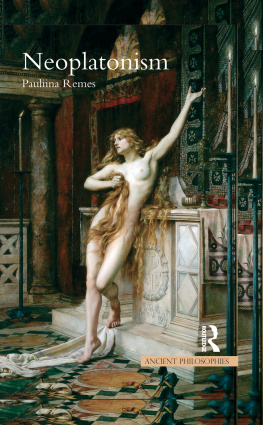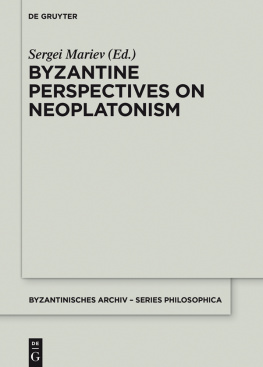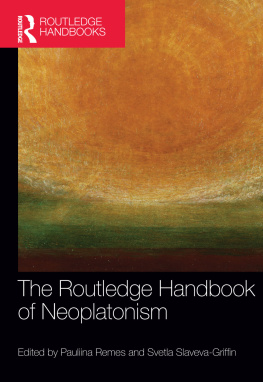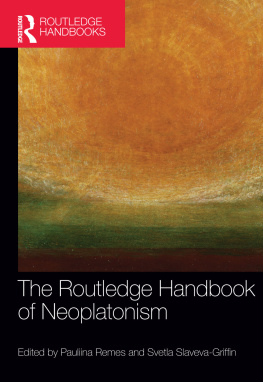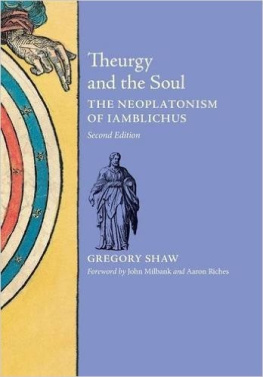Neoplatonism
Ancient Philosophies
This series provides fresh and engaging new introductions to the major schools of philosophy of antiquity. Designed for students of philosophy and classics, the books offer clear and rigorous presentation of core ideas and lay the foundation for a thorough understanding of their subjects. Primary texts are handled in translation and the readers are provided with useful glossaries, chronologies and guides to the primary source material.
Published
Cynics
William Desmond
Neoplatonism
Pauliina Remes
Presocratics
James Warren
Stoicism
John Sellars
Forthcoming
Ancient Commentators on Plato and Aristotle
Miira Tuominen
Ancient Scepticism
Harald Thorsrud
Aristotle
Vasilis Politis
Confucianism
Paul Goldin
Epicureanism
Tim OKeefe
Classical Islamic Philosophy
Deborah Black
Plato
Andrew Mason
Socrates
Mark McPherran
Neoplatonism
Pauliina Remes
First published in 2008 by Acumen
Published 2014 by Routledge
2 Park Square, Milton Park, Abingdon, Oxon OX14 4RN
711 Third Avenue, New York, NY 10017, USA
Routledge is an imprint of the Taylor and Francis Group, an informa business
Pauliina Remes, 2008
This book is copyright under the Berne Convention.
No reproduction without permission.
All rights reserved. No part of this book may be reprinted or reproduced or utilised in any form or by any electronic, mechanical, or other means, now known or hereafter invented, including photocopying and recording, or in any information storage or retrieval system, without permission in writing from the publishers.
Notices
Practitioners and researchers must always rely on their own experience and knowledge in evaluating and using any information, methods, compounds, or experiments described herein. In using such information or methods they should be mindful of their own safety and the safety of others, including parties for whom they have a professional responsibility.
To the fullest extent of the law, neither the Publisher nor the authors, contributors, or editors, assume any liability for any injury and/or damage to persons or property as a matter of products liability, negligence or otherwise, or from any use or operation of any methods, products, instructions, or ideas contained in the material herein.
ISBN: 978-1-84465-124-5 (hardcover)
ISBN: 978-1-84465-125-2 (paperback)
British Library Cataloguing-in-Publication Data
A catalogue record for this book is available from the British Library.
Designed and typeset in Minion by Kate Williams, Swansea.
Contents
In school in the 1970s I learned that the world does not consist only of human beings, trees, cars, colours or even the materials these are composed of; rather, everything is made of tiny, invisible atoms that function according to their own laws. What we perceive and identify in our everyday life emerges from these basic elements that we cannot perceive in ways only the experts know and understand. By the 1970s, atoms were no longer considered indivisible ( atomoi ), and their more subtle internal structure had been described. Since then, even smaller entities have become the subjects of mainstream physics; these subatomic particles are even further removed from the direct empirical gaze of the perceiver, and from the direct sight of the physicists. Scientists introduce such theoretical entities as quarks and strings to explain the elementary constituents of matter and radiation. For their part, these explicate the true elemental structures of the universe. Importantly for our purposes, the establishment of these new entities has not meant a replacement of, say, an atomic level of explanation, but the opening of a new level of reality and its study. Reality seems to be constituted of a hierarchy of levels, only one of which we are directly aware of.
In late antiquity the philosophical movement called Neoplatonism flourished in cultural centres of the Mediterranean such as Alexandria, Rome and Athens. This school of thought, which prospered from the third century well into the sixth century CE and beyond, shares certain important features with contemporary physics. Like physics, it concentrates on revealing the order of the universe, working on the assumption that although this order is not directly perceivable, a correct combination of gathering information through perception and theorizing about it will reveal its basic nature to human reason. Again like physics, Neoplatonism postulates levels of being on which different entities and different characteristics appear, all of them explanatory of this very same world we see and live in. Some of these levels and entities are more speculative than others. As in physics, these levels are hierarchically ordered, each level functioning as an explanatory level proper for certain phenomena, having a complex relation to the levels and entities above and below. In both theories, the subtleties of the cross-level relations are as, or even more, problematic than the study of the levels themselves and the entities they consist of. In sum, what is shared by Neoplatonists and some modern physicists is a speculative effort and readiness to postulate theoretical entities that form a layered reality inaccessible to perception.
For the comparison to illuminate rather than distort, however, we should also note the paramount differences. Unlike most contemporary physics, Neoplatonism treats matter as inert and without any properties of its own, claiming that what is basic and most truly existing is pure order, not qualities of matter nor even the realization of order in matter. The Neoplatonic explanations of phenomena do not seek constitutive, simple elements of which things are composed, but share the general Platonic tendency of appealing to intelligible principles. This has been called Platonic top-downism as opposed to the bottom-upism of many theories currently in fashion (Gerson 2005b: 25960). Undoubtedly, too, the levels and the entities postulated are completely different in the two theories. It is also likely that Neoplatonists went much further than most modern physics in their methodology, in which the justification for the theory is not sought in how well the empirical studies and their results fit the theory, but in matters internal to the theory: its completeness, consistency and rational plausibility. Although the starting-points for the study are the experiences and perceptions of the enquirer, ultimately the theoretical considerations outweigh comparisons with experience. It is important in this context to recall that at the time of Neoplatonism, systematic empirical science had not yet been developed. In their speculative spirit and readiness to postulate theoretical entities, however, many modern physicists are Platonist in spirit, some of them manifestly so.
Thus we might claim that present-day physics and Neoplatonic metaphysics both start from perceptible reality and share the tendency to postulate further layers of reality foreign to the common man, but that they are poles apart in choosing their direction. Where physics proceeds downwards by penetrating the subtleties of material or physical structures of the universe, Neoplatonists separated themselves from what they considered matters limitations, and sought a purely intelligible order. For intuitions nestled in contemporary science, this move may seem fatal, but to grasp and appreciate some of the basic Neoplatonic insights it is enough to allow the possiblity of a multilayered reality penetrable to reason.

